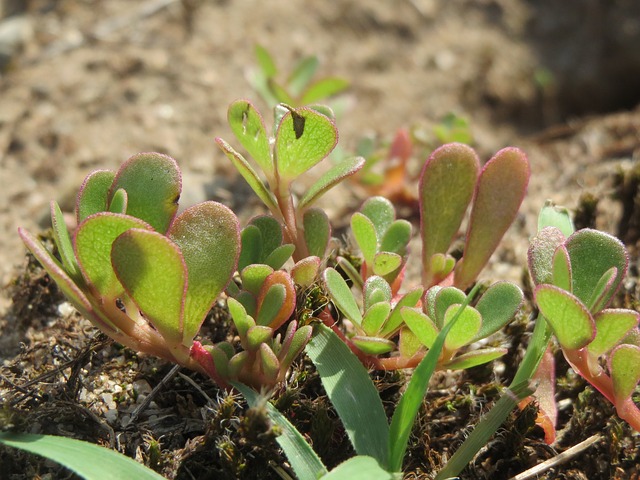Words: Dr Chaithra S RAO
The COVID-19 lockdown acquainted us with this wonderful weed, or herb — a truly appetising super-food.
We were ‘locked’ in a village with meagre supplies. We had no choice, but to rely on indigenously grown produce — for the most part, the various weeds that were sprouting, with no effort, and providing us with good nutrition and taste. This ensured, no less, that our city-oriented, also a tad bored, palate got ‘jazzed-up’ to fresh, new victuals.
You’d call this, as Shakespeare articulated, “Sweet are the uses of adversity.”
The weed, we are going to discuss this month, is endowed with the WHO ‘moniker’ — global panacea. It goes by the name, Portulaca oleracea. It is popularly called purslane, or goli, or goni soppu in Kannada, lonika and bruhat lonika in Sanskrit, loni-noni-loniya-noniya [chhoti and badi], kulpha in Hindi, kshudre nuni and bade nuni in Bengali, ghola and bhui ghola in Marathi, luni in Gujarati, goddu pavelli in Telugu, pasalai and siru pasalai in Tamil, and neelakeera in Malayalam.
Purslane sounds so much like Penny Lane, a lilting number by the one and the only Beatles — with a difference. The former not only sounds good to your ears, but also your palate.
It is interesting to note that the seeds of purslane, from the Bronze Age, were found in Northern Italy. They were also found in Greece, dating back to 7th Century BC.
The Purslane Catalogue
Purslane has an abundance of phytochemical constituents. The leaves are mucilaginous and rich in potassium oxalate [so, the herb should be used with caution in renal calculi]. The whole plant is rich in vitamins C, A, B-1, B-2, B-6 and norepinephrine. The plant is rich in omega-3 fatty acids too; the seeds contain fixed oil, β-sitosterol.
Purslane also aptly paves its way from the plate to the palate, because it is one of the most palatable herbs which is just as delightfully nutritious.
Bhava Prakasha Nighantu, the 16th Century AD treatise, describes two varieties of lonika-loni [Portulaca quadrifida] and bruhat loni/ghotika [Portulaca oleracea]. Loni possesses sour and salty tastes; it is useful in alleviating tastelessness, haemorrhoids [piles], abdominal and digestive disorders, including toxins. It also mitigates kapha-pitta dosha. Bruhat lonika possesses similar qualities — it is just as useful in speech disorders, cough, breathlessness, urinary and eye disorders, besides —
- The external application of fresh leaf paste is indicated in herpes and other conditions with a prevailing burning sensation
- Oral administration of phanta [hot infusion] is advised in difficult, burning urination and bleeding disorders
- The seeds are anti-microbial, also anthelminthic — they may be taken orally in intestinal worm infestations
- Leaf juice with honey, or a combination with ginger juice and honey, is advised for cough.
Dosage
Leaf juice/infusion: 50ml-100ml; seed [powder], 6-10gm.
The Purslane Smorgasbord
- Salad. This is a deliciously appetising recipe with a sour peppery ‘kick’ of fresh purslane. Raw purslane can be used as a salad with oil dressing, singly, or in combination with other raw vegetables and nuts
- Purslane dal/kootu/sambhar. Roasted purslane is cooked in a lentil, masala-based gravy
- Chutney. Roasted purslane grinded with coconut, pepper and seasoned to go well with hot rice
- Sasive/gojju. Roasted purslane in a grinded coconut, mustard, chilli-based gravy, well-seasoned. It is a classy accompaniment for rice/roti
- Purslane dosa. A spicy batter of soaked rice, red chillies, coriander, cumin, tamarind, and salt, is mixed with chopped purslane and slowly cooked on a griddle
- Purslane fritters. Chopped purslane in a spicy rice batter; deep fried
- Steamed, or sautéed. Plain sauté, or steamed purslane, can be delicious with its own flavour and lusciousness
- Soup. Roasted purslane pureed and garnished with cream, butter, salt and pepper
- Purslane bakleh. A Lebanese recipe for crispy puff pastry pockets with purslane filling — a delectable snack
- Purslane chimichurri. This is an Argentinian recipe, replete with a garlicky, sour condiment, and served with barbecued meat.

